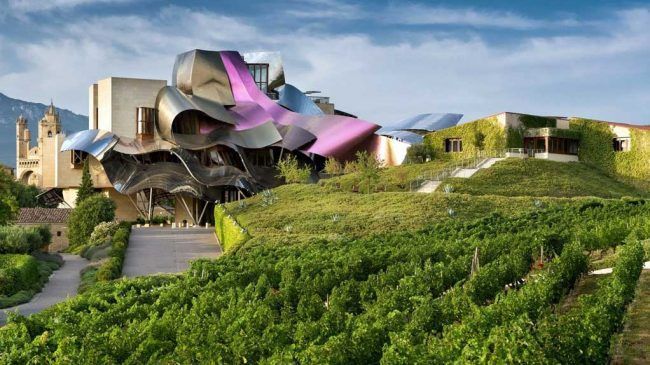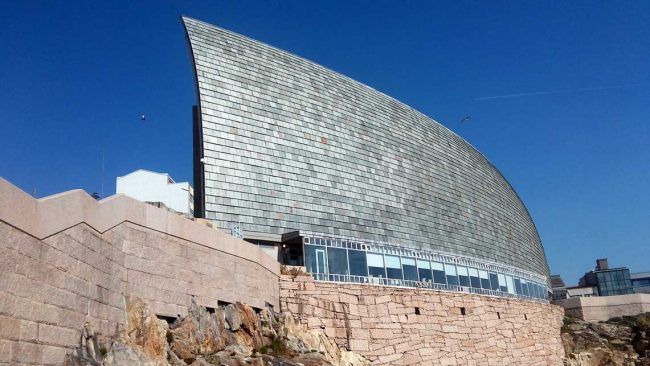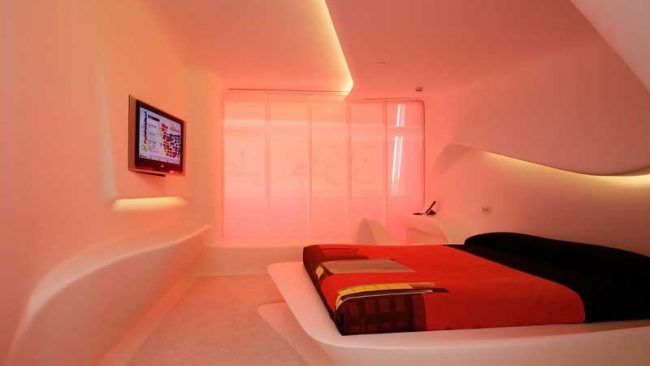The 2021 Pritzker Prize, the “Nobel Prize” of architecture, has recently been awarded to architects Anne Lacaton and Jean-Philippe Vassal. It’s then the perfect time to take a tour around Spain and discover 15 buildings you may or may not know are signed by Pritzker Prize winners!
Philip Johnson, Gate of Europe towers or “Torres Kio”, Madrid, 1996
Philip Johnson was the first person ever to have been awarded the Prize in 1979. Ten years after this feat, he and John Burgee started designing these twin office buildings in Madrid.

The Gate of Europe towers, inaugurated in 1996, were the world’s first inclined skyscrapers (15° both). The uniqueness of these 115m tall iconic buildings made them the perfect setting for various movies, and even a cartoon!
Frank Gehry, Hotel Marqués de Riscal in Elciego, 2006
Would you believe this is an almost-two-century-old winery? Following the example of Santiago Calatrava’s makeover of the Bodegas Ysios in Rioja Alavesa, Canadian architect and 1989 Pritzker Prize winner Frank Gehry redesigned this established Spanish winery in the Wine Trail of Rioja. After the success of the Guggenheim Museum in Bilbao, Frank Gehry transformed the Marqués de Riscal winery into a whole hotel complex and “a marvellous creature, with hair flying everywhere“.

In terms of design, the architect has stated that the building reflected a Marqués de Riscal bottle. Indeed, the pink ribbon-like titanium panels reflect the pink hues of Rioja. The silver is to represent the foil covering the cork. Finally, the use of gold is meant to conjure up the idea of the mesh adorning the Marques de Riscal bottles.
Zaha Hadid, Lopez De Heredia Wine Pavilion, Hora, 2006
Wine and architecture again! Another demonstration of this successful mix is this Wine Pavilion designed by Zaha Hadid for R. Lopez de Heredia’s 125th anniversary.

The modern and curvy appearance of the pavilion meddles with the tradition of this winery. In the architect’s own words, this is “a bridge between the past, present, and future evolution of its world-famous bodegas“. Zaha Hadid is the first ever woman to have been awarded the Pritzker Prize in 2004. In Spain, she is also known for her Bridge Pavilion in Zaragoza.
Jean Nouvel, Torre Agbar/Torre Glòries, Barcelona, 2005
French architect Jean Nouvel was awarded the Pritzker Prize in 2008. But before that, with Fermín Vázquez, he designed Torre Gloriès, one of the most iconic buildings of Barcelona and the third tallest building in the city.

This 144m bullet-shaped tower is now a symbol of the new technological district of Barcelona. Indeed, the materials used for this construction were concrete, aluminium and glass, which gives the tower a futuristic appearance. Although this tower seems out of place for some inhabitants, the Torre Gloriès has become an important part of the Barcelonan skyline!
Richard Meier, Barcelona Museum of Contemporary Art, 1995
Let’s stay in Barcelona and take a look at the Museum of Contemporary Art! It is another piece of modernity, located in some of Barcelona’s oldest streets and buildings, close to the Gothic centre.

This museum’s architect Richard Meier was awarded the Pritzker Prize in 1984. In his own words, “this museum plays a key role in restructuring the Gothic district of Barcelona”. In terms of architecture, the building shows modernist influences, Le Corbusier being a major reference for Richard Meier.
Rafael Moneo, Murcia Town Hall on the Cardenal Belluga Plaza, 1998
Another contrast between modernity and tradition is to be seen in the Murcia Town Hall façade on the Cardenal Belluga Plaza.

The challenge for 1996 Pritzker Prize winner Rafael Moneo was to design a modern institutional building between two religious ones of strong historical tradition: a 16th century cathedral and the Episcopal Palace from 1768. Even twenty years after the completion of the town hall, some inhabitants still think that it is incongruous on such a historical Plaza.
Norman Foster, Torre Cepsa, Madrid, 2008
The Torre Cepsa is also called the Foster Tower, after the architect who designed it: 1999 Pritzker Prize winner and famous British architect Norman Foster.

What is most striking with Torre Cepsa is its height. This glass and steel skyscraper of 250m and 45 floors is it the second tallest of both the four “torres” in the Cuatro Torres Business Area complex and Spain. It is also the 5th tallest building in the European Union!
Norman Foster, Congress Centre, Valencia, 1998
Valencia has its Pritzker-Prize-winner-designed building as well! Norman Foster signed the Valencian Congress Centre, which was inaugured a year before he received the prize. Did Valencia make him win? We’ll never know. But what it certain is that the Congress was tailored for our city.

The Mediterranean climate is optimized: the large canopy provides shades, the pools some cool air, and the Valencian sunlight floods the building. Located on the outskirts of the old town, this modern building using local architectural skills is, as the architect stated, “truly a Valencian building – rooted in tradition but forward looking.”
Arata Isozaki, Domus la Casa del Hombre, A Coruña, 1995
The 2019 Pritzker Prize winner designed some buildings in Spain! One of his most famous is a collaboration with César Portela: the Domus, a science museum dedicated to mankind in A Coruña.

The grandiose Galician setting of cliffs and ocean does not put this modernist building in the shades! On the contrary, the museum perfectly fits in the maritime environment. Indeed, the façade made of no less than 6,600 slate tiles gives the impression of curving like a billowing sail in the wind…
Jacques Herzog and Pierre de Meuron, BBVA headquarters, Madrid, 2015
These Swiss architects were awarded the Pritzker Prize in 2001. Almost fifteen years later, they signed the main building of the BBVA Headquarters in Madrid, one of Madrid’s architectural landmarks.

Sustainability was a major criterion when designing the building. To limit the use of AC, the architects dealt with the Southern Europe climatic conditions by using brise-soleil and insulative materials. Besides, this 93-metre high building has an innovative ovoid shape which is reminiscent of its name, “La Vela” (“The Sail”).
Renzo Piano, Centro de Arte Botín, Santander, 2017
Renzo Piano was awarded the Pritzker Prize in 1998 but didn’t stop designing amazing buildings and places after that! In 2017, his and Luis Vidal’s Centro de Arte Botín was inaugurated in Santander.

With a total area spanning of around 9,000m², the building is composed of two volumes of different sizes supported on columns and suspended partially on the sea. Because the ground floor is supported by columns, the sea is plainly visible from the park. This has turned this Centro into a unique and nice urban space for Santander inhabitants!
Oscar Niemeyer, International Cultural Centre, Asturias, 2011
The most famous Brazilian architect was awarded the Pritzker prize in 1988. His only work in Spain is the International Cultural Centre or Niemeyer Centre in Asturias and draws inspiration from Neoplasticism and its use of colours.

And indeed, the International Cultural Centre in Asturias is a vibrant piece of contemporary architecture, all in white but for some contrasting blue, yellow and red elements. Thus, it marks a striking contrast with the old town and the traditional industrial image of the area.
Toyo Ito, “Fira Towers” Torre Realia BCN and Hotel Porta Fira, Barcelona, 2009
These two red towers of 112m each on the Plaza de Europa were designed by Toyo Ito, 2013 Pritzker Prize winner, in collaboration with Fermín Vázquez. To the architects’ own words, “the Torres Fira project is the gateway to the new Hospitalet de Llobregat trade fair zone”.

The Torre Realia BCN has 24 floors and a translucent appearance with a cylindrical red core. The second tower, distorted-cylinder-shaped Hotel Porta Fira, won the Emporis Award for the Best Skyscraper of 2010. It is slightly higher than the Torre Realia BCN, making it the tallest skyscraper in the municipality and the 5th highest in the metropolitan area of Barcelona!
Rafael Aranda, Carme Pigem and Ramon Vilalta, Guardería “Els Colors”, Manlleu, 2004
This Spanish trio won the Pritzker Prize in 2017, but they had already signed some buildings in their native region, Catalunya, before that! The colourful Manlleu “Els Colors” nursery which was inaugurated in 2004 is one of them.

The building draws inspiration from construction games, by juxtaposing and superimposing simple pieces. The glass colours, red, orange and yellow create a cheerful and very striking environment for the little ones. With this project, the architects wanted to design a place for children, using their perspective.
Jean Nouvel et al., Hotel Puerta America, Madrid, 2005
Not one, not two, not three, but four Pritzker Prize winners took part in this building’s design!

Jean Nouvel (2008) oversaw the attic, the twelfth floor and the façade, which he decorated with lines in various languages of the poem “Liberté” by Paul Éluard. Zaha Hadid (2004) took care of the first floor and designed it with curves and a peculiar white and light atmosphere. This floor was described as “A space of quasi-science fiction”. Norman Foster (1999) took care of the second floor in the spirit of “elegance, luxury and flexibility”. Finally, Arata Isozaki (2019) designed the tenth floor with Japanese traditional home influences, using wood panels and conferring a subtle, relaxing atmosphere. Other floors were designed by renowned architects or designers such as David Chipperfield, Ron Arad or Marc Newson.
This makes this hotel a major collaborative work with internationally famous architect and designers coming together, all this in central Madrid.
This list of Pritzker Prize winners who chose Spain shows its attractiveness and central role in the world of architecture! You can also check 10 other buildings which makes of Spain a reference country in modern architecture.


























